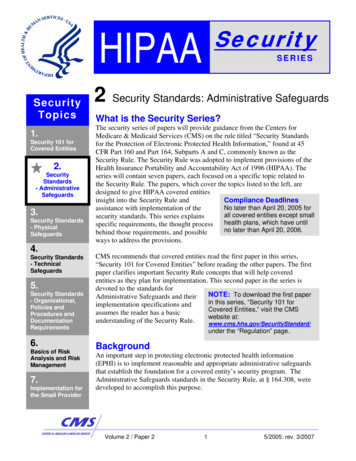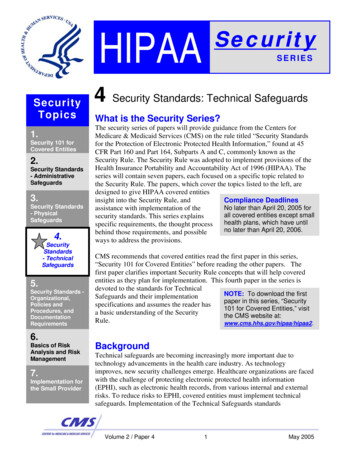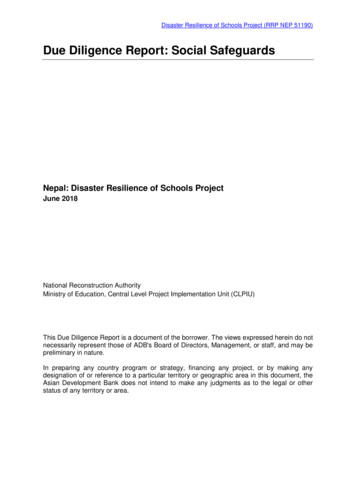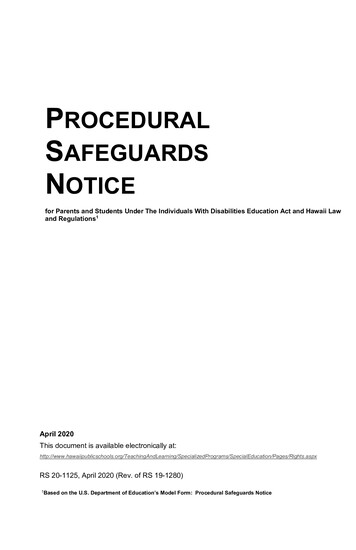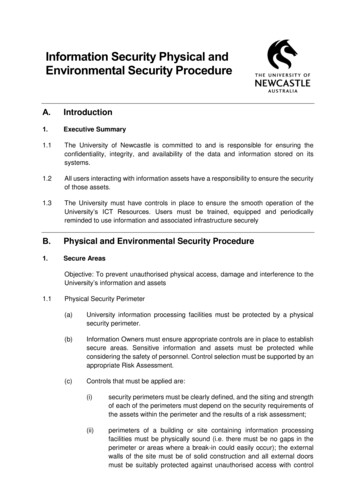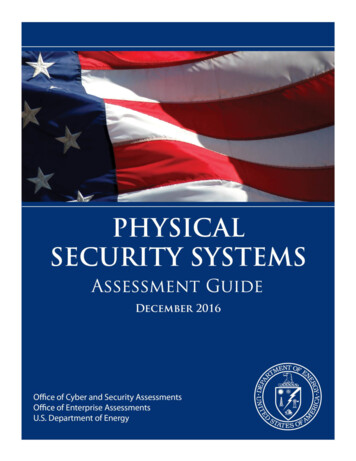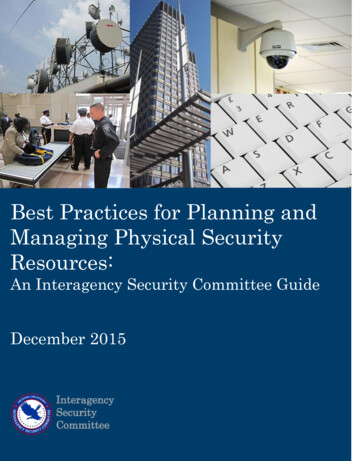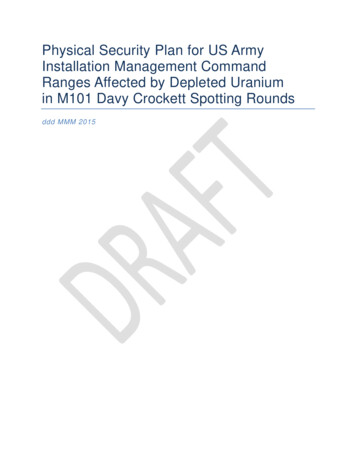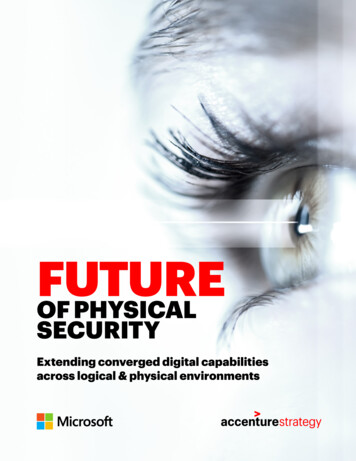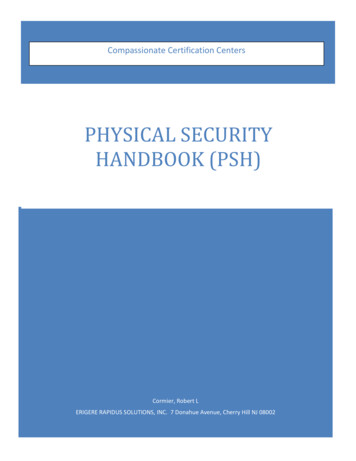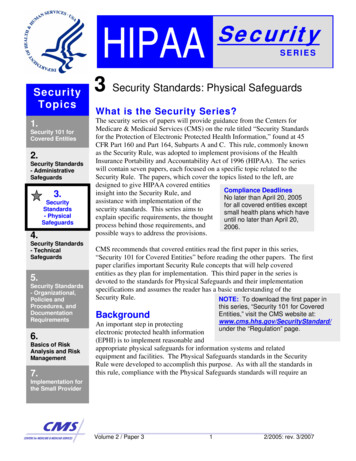
Transcription
SecurityHIPAASecurityTopics1.Security 101 forCovered Entities2.Security Standards- AdministrativeSafeguards3.SecurityStandards- PhysicalSafeguards4.Security Standards- TechnicalSafeguards5.Security Standards- Organizational,Policies andProcedures, andDocumentationRequirements6.Basics of RiskAnalysis and RiskManagement7.SERIES3 Security Standards: Physical SafeguardsWhat is the Security Series?The security series of papers will provide guidance from the Centers forMedicare & Medicaid Services (CMS) on the rule titled “Security Standardsfor the Protection of Electronic Protected Health Information,” found at 45CFR Part 160 and Part 164, Subparts A and C. This rule, commonly knownas the Security Rule, was adopted to implement provisions of the HealthInsurance Portability and Accountability Act of 1996 (HIPAA). The serieswill contain seven papers, each focused on a specific topic related to theSecurity Rule. The papers, which cover the topics listed to the left, aredesigned to give HIPAA covered entitiesCompliance Deadlinesinsight into the Security Rule, andNo later than April 20, 2005assistance with implementation of thefor all covered entities exceptsecurity standards. This series aims tosmall health plans which haveexplain specific requirements, the thoughtuntil no later than April 20,process behind those requirements, and2006.possible ways to address the provisions.CMS recommends that covered entities read the first paper in this series,“Security 101 for Covered Entities” before reading the other papers. The firstpaper clarifies important Security Rule concepts that will help coveredentities as they plan for implementation. This third paper in the series isdevoted to the standards for Physical Safeguards and their implementationspecifications and assumes the reader has a basic understanding of theSecurity Rule.NOTE: To download the first paper inthis series, “Security 101 for CoveredEntities,” visit the CMS website at:www.cms.hhs.gov/SecurityStandard/under the “Regulation” page.BackgroundAn important step in protectingelectronic protected health information(EPHI) is to implement reasonable andappropriate physical safeguards for information systems and relatedequipment and facilities. The Physical Safeguards standards in the SecurityRule were developed to accomplish this purpose. As with all the standards inthis rule, compliance with the Physical Safeguards standards will require anImplementation forthe Small ProviderVolume 2 / Paper 312/2005: rev. 3/2007
3 Security Standards: Physical SafeguardsHIPAA SECURITYSTANDARDSSecurity Standards:General Rules---ADMINISTRATIVESAFEGUARDSSecurity ManagementProcessAssigned SecurityResponsibilityWorkforce SecurityInformation AccessManagementSecurity Awarenessand TrainingSecurity IncidentProceduresContingency PlanEvaluationBusiness AssociateContracts and OtherArrangementsPHYSICALSAFEGUARDSFacility AccessControlsWorkstation UseWorkstation SecurityDevice and MediaControlsTECHNICALSAFEGUARDSAccess ControlSTANDARDAudit ControlsIntegrity164.310(a)(1)Person or EntityAuthenticationTransmission SecurityORGANIZATIONALREQUIREMENTS- Business AssociateContracts and OtherArrangements- Requirements forGroup Health PlansPOLICIES andPROCEDURES andDOCUMENTATIONREQUIREMENTSevaluation of the security controls already in place, an accurate andthorough risk analysis, and a series of documented solutions derived from anumber of factors unique to each covered entity.The objectives of this paper are to:Review each Physical Safeguard standard andimplementation specification listed in the Security Rule.Discuss physical vulnerabilities and provide examples ofphysical controls that may be implemented in a coveredentity’s environment.Provide sample questions that covered entities may wantto consider when implementing the Physical Safeguards.What are physical safeguards?The Security Rule defines physical safeguards as “physical measures,policies, and procedures to protect a covered entity’s electronic informationsystems and related buildings and equipment, from natural andenvironmental hazards, and unauthorized intrusion.” The standards areanother line of defense (adding to the Security Rule’s administrative andtechnical safeguards) for protecting EPHI.When evaluating and implementingthese standards, a covered entity mustconsider all physical access to EPHI.This may extend outside of an actualoffice, and could include workforcemembers’ homes or other physicallocations where they access EPHI.STANDARD§ 164.310(a)(1)NOTE: A matrix of all of theSecurity Rule Standards andImplementation Specificationsis included at the end of thispaper.Facility Access ControlsThe first standard under the Physical Safeguards section is Facility AccessControl. It requires covered entities to:“Implement policies and procedures to limit physical access to its electronicinformation systems and the facility or facilities in which they are housed,while ensuring that properly authorized access is allowed.”Volume 2 / Paper 322/2005: rev. 3/2007
3 Security Standards: Physical SafeguardsA facility is defined in the rule as “the physical premises and the interior and exterior of abuilding(s)”.NOTE: For a more detailedSample questions for covered entities to consider:Are policies and procedures developed and implementedthat address allowing authorized and limiting unauthorizedphysical access to electronic information systems and thefacility or facilities in which they are housed?discussion of “addressable”and “required” implementationspecifications, see the firstpaper in this series, “Security101 for Covered Entities.”Do the policies and procedures identify individuals (workforce members, businessassociates, contractors, etc.) with authorized access by title and/or job function?Do the policies and procedures specify the methods used to control physical accesssuch as door locks, electronic access control systems, security officers, or videomonitoring?The Facility Access Controls standard has four implementation specifications.1.2.3.4.Contingency Operations (Addressable)Facility Security Plan (Addressable)Access Control and Validation Procedures (Addressable)Maintenance Records (Addressable)1. CONTINGENCY OPERATIONS (A) - § 164.310(a)(2)(i)The Contingency Operations implementation specification refers to physicalsecurity measures entities establish in the event of the activation of contingencyplans and employ while the contingency plansNOTE: Facility access controlsrequired by the Administrative Safeguards areimplementation specifications areactive.addressable. This means thataccess controls duringcontingency operations may varysignificantly from entity to entity.Where this implementation specification is areasonable and appropriate safeguard for acovered entity, the covered entity must:“Establish (and implement as needed) procedures that allow facilityaccess in support of restoration of lost data under the disaster recoveryplan and emergency mode operations plan in the event of an emergency.”Contingency operations may be set in motion during or immediately following adisaster or emergency situation. During contingency operations, it is important toVolume 2 / Paper 332/2005: rev. 3/2007
3 Security Standards: Physical Safeguardsmaintain physical security and appropriate access to EPHI while allowing for datarestoration activities.Facility access controls during contingency operations will vary significantlyfrom entity to entity. For example, a large covered entity may need to post guardsat entrances to the facility or have escorts for individuals authorized to access thefacility for data restoration purposes. For smaller operations, it may be sufficientto have all staff involved in the recovery process.Sample questions for covered entities to consider:Are procedures developed to allow facility access while restoring lost data inthe event of an emergency, such as a loss of power?Can the procedures be appropriately implemented, as needed, by thoseworkforce members responsible for the data restoration process?Do the procedures identify personnel that are allowed to re-enter the facility toperform data restoration?Is the content of this procedure also addressed in the entity’s contingencyplan? If so, should the content be combined?2. FACILITY SECURITY PLAN (A) - § 164.310(a)(2)(ii)The Facility Security Plan defines and documents the safeguards used by thecovered entity to protect the facility or facilities.Where this implementation specification is a reasonable and appropriatesafeguard for a covered entity, the covered entity must:“Implement policies and procedures to safeguard the facility and theequipment therein from unauthorized physical access, tampering, andtheft.”Facility security plans must document the use ofNOTE: Facility securityphysical access controls. These controls mustplans document the use ofensure that only authorized individuals havephysical access controls.access to facilities and equipment that containEPHI. In general, physical access controls allow individuals with legitimatebusiness needs to obtain access to the facility and deny access to those withoutlegitimate business needs. Procedures must also be used to prevent tampering andtheft of EPHI and related equipment.Volume 2 / Paper 342/2005: rev. 3/2007
3 Security Standards: Physical SafeguardsTo establish the facility security plan, covered entities should review risk analysisdata on persons or workforce members that need access to facilities andequipment. This includes staff, patients, visitors and business partners.Some common controls to prevent unauthorized physical access, tampering, andtheft that covered entities may want to consider include:Locked doors, signs warning of restricted areas, surveillancecameras, alarmsProperty controls such as property control tags, engraving onequipmentPersonnel controls such as identification badges, visitor badgesand/or escorts for large officesPrivate security service or patrol for the facilityIn addition, all staff or employees must knowtheir roles in facility security. Covered entitiesmust review the plan periodically, especiallywhen there are any significant changes in theenvironment or information systems.NOTE: The facility securityplan should be an integralpart of a covered entity’sdaily operations.Sample questions for covered entities to consider:Are policies and procedures developed and implemented to protect the facilityand associated equipment against unauthorized physical access, tampering,and theft?Do the policies and procedures identify controls to prevent unauthorizedphysical access, tampering, and theft, such as those listed in the commoncontrols to consider bullets above?3. ACCESS CONTROL AND VALIDATION PROCEDURES (A)- § 164.310(a)(2)(iii)The Facility Access Controls standard also includes the Access Control andValidation Procedures implementation specification. Where this implementationspecification is a reasonable and appropriate safeguard for a covered entity, thecovered entity must:“Implement procedures to control and validate a person’s access tofacilities based on their role or function, including visitor control, andcontrol of access to software programs for testing and revision.”Volume 2 / Paper 352/2005: rev. 3/2007
3 Security Standards: Physical SafeguardsThe purpose of this implementation specification is to specifically align aperson’s access to information with his or her role or function in the organization.These functional or role-based access control and validation procedures should beclosely aligned with the facility security plan. These procedures are the means bywhich a covered entity will actually determine the workforce members or personsthat should have access to certain locations within the facility based on their roleor function.NOTE: The SecurityThe controls implemented will depend on the coveredRulerequires that aentity’s environmental characteristics. For example,coveredentity documentit is common practice to question a person’s identitythe rationale for allby asking for proof of identity, such as a picture ID,security decisions.before allowing access to a facility. In a largeorganization, because of the number of visitors and employees, this practice maybe required for every visit. In a small doctor’s office, once someone’s identity hasbeen verified it may not be necessary to check identity every time he or she visits,because the identity would already be known.Sample questions for covered entities to consider:Are procedures developed and implemented to control and validate a person’saccess to facilities based on their role or function, including visitor control,and control of access to software programs for testing and revision?Do the procedures identify the methods for controlling and validating anemployee’s access to facilities, such as the use of guards, identificationbadges, or entry devices such as key cards?Do the procedures also identify visitor controls, such as requiring them to signin, wear visitor badges and be escorted by an authorized person?Do the procedures identify individuals, roles or job functions that areauthorized to access software programs for the purpose of testing and revisionin order to reduce errors?Does management regularly review the lists of individuals with physicalaccess to sensitive facilities?4. MAINTENANCE RECORDS (A) - § 164.310(a)(2)(iv)Covered entities may make many types of facility security repairs andmodifications on a regular basis, including changing locks, making routinemaintenance checks and installing new security devices.Volume 2 / Paper 362/2005: rev. 3/2007
3 Security Standards: Physical SafeguardsThe Maintenance Records implementation specification requires that coveredentities document such repairs and changes. Where this implementationspecification is a reasonable and appropriate safeguard for a covered entity, thecovered entity must:“Implement policies and procedures to document repairs andmodifications to the physical components of a facility which are related tosecurity (for example, hardware, walls, doors and locks).”In a small office, documentation may simply be a logbook that notes the date,reason for repair or modification and who authorized it. In a large organization,various repairs and modifications of physical security components may need to bedocumented in more detail and maintained in a database.NOTE: Documentation ofIn some covered entities the most frequentmaintenance records mayphysical security changes may be re-keying doorvary from a simple logbook tolocks or changing the combination on a door,a comprehensive database.when someone from the workforce has beenterminated. Some facilities may use door locks that rely on a card or badgereader. Documentation on the repair, addition, or removal of these devices mayalso be needed to meet this specification.Sample questions for covered entities to consider:Are policies and procedures developed and implemented that specify how todocument repairs and modifications to the physical components of a facilitywhich are related to security?Do the policies and procedures specify all physical security components thatrequire documentation?Do the policies and procedures specify special circumstances when repairs ormodifications to physical security components are required, such as, whencertain workforce members (e.g., Application Administrators) with access tolarge amounts of EPHI are terminated?STANDARD§ 164.310(b)Workstation UseThe next standard in the Physical Safeguards is Workstation Use. A workstation is defined inthe rule as “an electronic computing device, for example, a laptop or desktop computer, or anyother device that performs similar functions, and electronic media stored in its immediateenvironment.”Volume 2 / Paper 372/2005: rev. 3/2007
3 Security Standards: Physical SafeguardsThe Workstation Use standard requires covered entities toNOTE: The Workstation Usespecify the proper functions to be performed by electronicandWorkstation Securitycomputing devices. Inappropriate use of computerstandards have noworkstations can expose a covered entity to risks, such asimplementation specifications,virus attacks, compromise of information systems, andbut like all standards must bebreaches of confidentiality. This standard has noimplemented.implementation specifications, but like all standards must beimplemented. The proper environment for workstations is another topic that this standardcovers.For this standard, covered entities must:“Implement policies and procedures that specify the proper functions to beperformed, the manner in which those functions are to be performed, and thephysical attributes of the surroundings of a specific workstation or class ofworkstation that can access electronic protected health information.”Many covered entities may have existing policies and procedures that address appropriatebusiness use of workstations. In these cases, it may be possible for them to update existingdocumentation to address security issues. Covered entities must assess their physicalsurroundings to ensure that any risks associated with a workstation’s surroundings are knownand analyzed for a possible negative impact.The Workstation Use standard also applies to covered entitieswith workforce members that work off site usingworkstations that can access EPHI. This includes employeeswho work from home, in satellite offices, or in anotherfacility. Workstation policies and procedures must specifythe proper functions to be performed, regardless of where theworkstation is located.NOTE: At a minimum, allsafeguards required foroffice workstations mustalso be applied toworkstations located off site.Some common practices that may already be in place include logging off before leaving aworkstation for an extended period of time, and using and continually updating antivirussoftware.Sample questions for covered entities to consider:Are policies and procedures developed and implemented that specify the properfunctions to be performed, the manner in which those functions are to be performed,and the physical attributes of the surroundings of a specific workstation or class ofworkstation that can access EPHI?Do the policies and procedures identify workstations that access EPHI and those that donot?Volume 2 / Paper 382/2005: rev. 3/2007
3 Security Standards: Physical SafeguardsDo the policies and procedures specify where to place and position workstations to onlyallow viewing by authorized individuals?Do the policies and procedures specify the use of additional security measures toprotect workstations with EPHI, such as using privacy screens, enabling passwordprotected screen savers or logging off the workstation?Do the policies and procedures address workstation use for users that access EPHI fromremote locations (i.e., satellite offices or telecommuters)?STANDARD§ 164.310(c)Workstation SecurityLike Workstation Use, Workstation Security is a standard with no implementation specifications.The Workstation Security standard requires that covered entities:“Implement physical safeguards for all workstations that access electronicprotected health information, to restrict access to authorized users.”While the Workstation Use standard addresses the policies and procedures for how workstationsshould be used and protected, the Workstation Security standard addresses how workstations areto be physically protected from unauthorized users.Covered entities may implement a variety of strategies to restrict access to workstations withEPHI. One way may be to completely restrict physical access to the workstation by keeping it ina secure room where only authorized personnel work.As with all standards and implementation specifications, what isreasonable and appropriate for one covered entity may not apply toanother. The risk analysis should be used to help with thedecision-making process.NOTE: For moreinformation about RiskAnalysis, see paper 6 inthis series, “Basics of RiskAnalysis and Ri
HIPAA Security SERIES Compliance Deadlines No later than April 20, 2005 for all covered entities except small health plans which have until no later than April 20, 2006. NOTE: To download the first paper in this series, “Security
